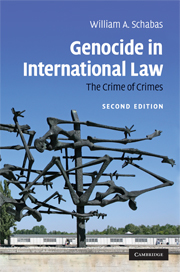Book contents
- Frontmatter
- Contents
- Preface to the first edition
- Preface to the second edition
- Acknowledgments
- List of abbreviations
- Introduction
- 1 Origins of the legal prohibition of genocide
- 2 Drafting of the Convention and subsequent normative developments
- 3 Groups protected by the Convention
- 4 The physical element or actus reus of genocide
- 5 The mental element or mens rea of genocide
- 6 ‘Other acts’ of genocide
- 7 Defences to genocide
- 8 Prosecution of genocide by international and domestic tribunals
- 9 State responsibility and the role of the International Court of Justice
- 10 Prevention of genocide
- 11 Treaty law questions and the Convention
- Conclusions
- Appendix: The three principal drafts of the Convention
- Bibliography
- Index
3 - Groups protected by the Convention
Published online by Cambridge University Press: 07 July 2009
- Frontmatter
- Contents
- Preface to the first edition
- Preface to the second edition
- Acknowledgments
- List of abbreviations
- Introduction
- 1 Origins of the legal prohibition of genocide
- 2 Drafting of the Convention and subsequent normative developments
- 3 Groups protected by the Convention
- 4 The physical element or actus reus of genocide
- 5 The mental element or mens rea of genocide
- 6 ‘Other acts’ of genocide
- 7 Defences to genocide
- 8 Prosecution of genocide by international and domestic tribunals
- 9 State responsibility and the role of the International Court of Justice
- 10 Prevention of genocide
- 11 Treaty law questions and the Convention
- Conclusions
- Appendix: The three principal drafts of the Convention
- Bibliography
- Index
Summary
The chapeau of article II of the Convention on the Prevention and Punishment of the Crime of Genocide states that the intent to destroy must be directed against one of four enumerated groups: national, racial, ethnical or religious. The Convention does not even invite application to what might be called analogous groups, a departure from General Assembly Resolution 96(I), which referred to ‘other groups’ in its definition of genocide. Moreover, the drafters of the Convention quite intentionally excluded ‘political’ groups from its scope, as they did reference to ‘ideological’, ‘linguistic’ and ‘economic’ groups. The Convention's list of protected groups has probably provoked more debate since 1948 than any other aspect of the instrument. This is often reflected in frustration that the victims of a particular atrocity, that otherwise would respond to the terms of the Convention, do not neatly fit within the four categories. According to scholars Frank Chalk and Kurt Jonassohn, ‘the wording of the Convention is so restrictive that not one of the genocidal killings committed since its adoption is covered by it’. They add that ‘potential perpetrators have taken care to victimize only those groups that are not covered by the convention's definition’.
The limited scope of the Convention definition has led many academics and human rights activists in two distinct directions. There have been frequent attempts to stretch the Convention definition, often going beyond all reason, in order to fit particular atrocities within the meaning of article II.
- Type
- Chapter
- Information
- Genocide in International LawThe Crime of Crimes, pp. 117 - 171Publisher: Cambridge University PressPrint publication year: 2009



